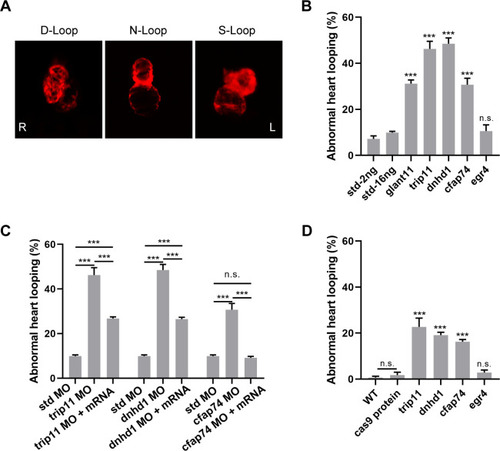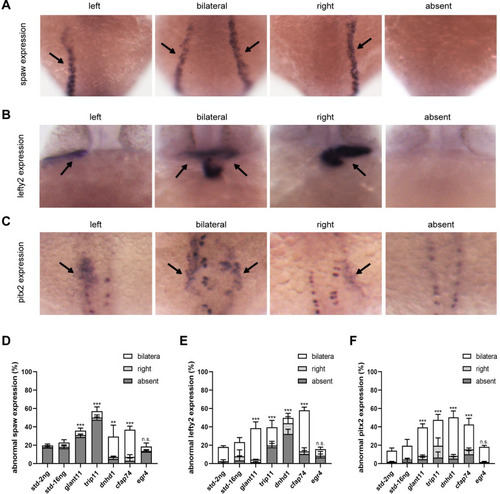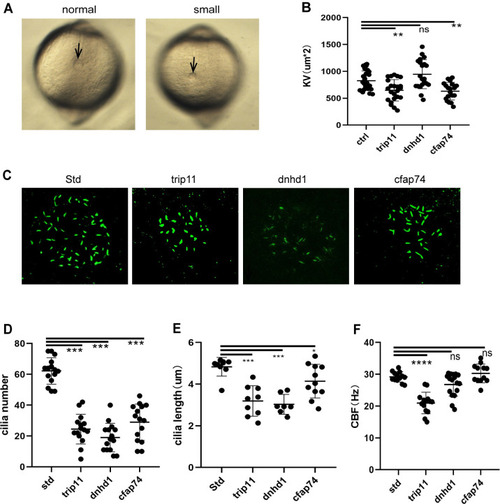- Title
-
LOF variants identifying candidate genes of laterality defects patients with congenital heart disease
- Authors
- Liu, S., Wei, W., Wang, P., Liu, C., Jiang, X., Li, T., Li, F., Wu, Y., Chen, S., Sun, K., Xu, R.
- Source
- Full text @ PLoS Genet.
|
Schematic of the methodology applied to identify candidate genes.
The results of ES performed on 70 patients were screened according to a series of criteria. 10226 rare variants were screened out. Among them, 776 LOF variants were selected for further analysis. 39 genes were identified from LOF variants for function and homology analysis. Finally, TRIP11, DNHD1, CFAP74, and EGR4 were selected as candidate genes for further study. |
|
Expression pattern of candidate genes at the indicated stages.
12hpf and 24hpf. (A, C, E, G, I) Results of in situ hybridization of candidate genes and standard control at the 12hpf (8?10 somites). (B, D, F, H, J) Results of in situ hybridization of candidate genes and standard control at the 24hpf (primordium 5 stage). Lateral view of embryos with anterior to the left. pronephric duct (green arrows), tail bud (red arrow), head (blue arrows). EXPRESSION / LABELING:
|
|
Knock-down of candidate genes disturbed heart looping.
(A) Different types of zebrafish heart are shown in Tg (cmlc2: eCherry) morphants in ventral view: dextral loop (normal), sinistral loop (abnormal), and no-loop (abnormal). (B) The percentage of abnormal heart looping with morphants injected. Bars show the total percent of abnormally looped hearts including two types: no-loop and sinistral loop hearts. (C) The corresponding mRNA can rescue LR randomization caused by MO of candidate genes. (D) The ratio of the abnormal heart looping of embryos generated by co-injection of zebrafish Cas9 mRNA and gRNA. Each experiment was repeated at least 3 times with > 50 embryos examined for each group every time. Standard MO (Std) is used as the negative control. galnt11MO is used as the positive control. Chi-squared test (continuity corrected) was used in B, C and D; *P <0.05, **P < 0.01, ***P < 0.001, respectively vs. Std-16ng (glant11, trip11, dnhd1, and cfap74) or Std-2ng (egr4). WT, wild type. PHENOTYPE:
|
|
The expression patterns of spaw, lefty2, and pitx2 at 18?24 hpf.
(A, C) the expression of spaw and pitx2 exhibit four patterns in LPM: left (normal), right (abnormal), bilateral (abnormal), or absent (abnormal). (B) The expression of lefty2 shows four patterns in the cardiac field: left (normal), right (abnormal), bilateral (abnormal), or absent (abnormal). (D-F) Summary of spaw, lefty2, and pitx2 mRNA expression in zebrafish morphants. Embryos are viewed dorsally with anterior to the top. Each experiment was repeated at least 3 times with > 50 embryos examined for each group every time. Chi-squared test (continuity corrected) was used in D, E and F; *P <0.05, **P < 0.01, ***P < 0.001, respectively vs. Std-16ng (glant11, trip11, dnhd1, and cfap74) or Std-2ng (egr4). EXPRESSION / LABELING:
PHENOTYPE:
|
|
Candidate genes are required for KV formation and ciliogenesis.
(A) The light-micro graph at the 8-somite stage showed different KV sizes, including normal and small. (B) The vesicle size of KV apical area. N?19. (C) Fluorescent immunostaining of cilia in KV using anti-?-Tubulin antibodies at the 12hpf. (D) LRO Cilia number per KV was quantified and the group values were expressed as the mean ± SD. N?15. (E) The average length of LRO Cilia per KV was quantified and the group values were expressed as the mean ± SD. N?7. (F) The ciliary beat frequency (CBF). N?12. Statistical significance was determined by Mann Whitney test; *P <0.05, ***P < 0.001, respectively vs. Std. EXPRESSION / LABELING:
PHENOTYPE:
|





